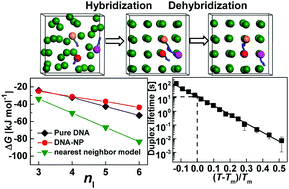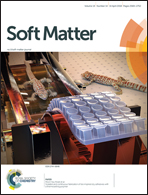Significance of DNA bond strength in programmable nanoparticle thermodynamics and dynamics†
Abstract
Assembly of nanoparticles (NPs) coated with complementary DNA strands leads to novel crystals with nanosized basic units rather than classic atoms, ions or molecules. The assembly process is mediated by hybridization of DNA via specific base pairing interaction, and is kinetically linked to the disassociation of DNA duplexes. DNA-level physiochemical quantities, both thermodynamic and kinetic, are key to understanding this process and essential for the design of DNA-NP crystals. The melting transition properties are helpful to judge the thermostability and sensitivity of relative DNA probes or other applications. Three different cases are investigated by changing the linker length and the spacer length on which the melting properties depend using the molecular dynamics method. Melting temperature is determined by sigmoidal melting curves based on hybridization percentage versus temperature and the Lindemann melting rule simultaneously. We provide a computational strategy based on a coarse-grained model to estimate the hybridization enthalpy, entropy and free energy from percentages of hybridizations which are readily accessible in experiments. Importantly, the lifetime of DNA bond dehybridization based on temperature and the activation energy depending on DNA bond strength are also calculated. The simulation results are in good agreement with the theoretical analysis and the present experimental data. Our study provides a good strategy to predict the melting temperature which is important for the DNA-directed nanoparticle system, and bridges the dynamics and thermodynamics of DNA-directed nanoparticle systems by estimating the equilibrium constant from the hybridization of DNA bonds quantitatively.



 Please wait while we load your content...
Please wait while we load your content...